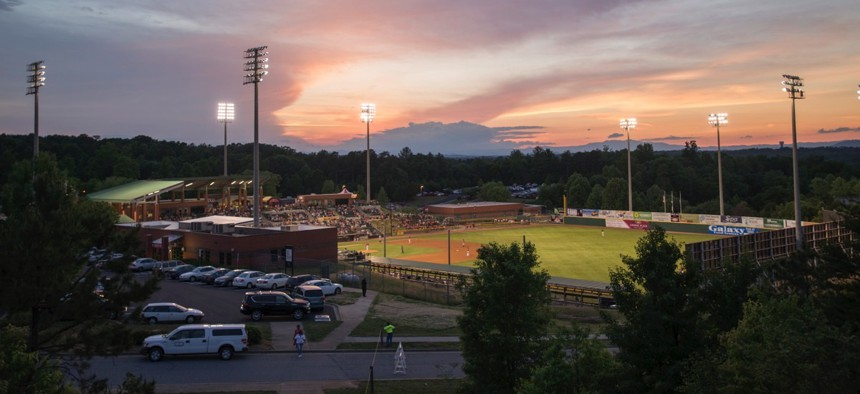A North Carolina City’s Big Aspiration: Attracting Millennials

The Hickory Crawdads minor league baseball team plays at L.P. Frans Stadium. North Carolina National Guard / Flickr CC BY-ND 2.0

Connecting state and local government leaders
“We recognized that we have some really cool things in this city, but we need to enhance them,” says Hickory’s city manager.
Hickory, North Carolina, is seeking millennials.
The city is getting ready to plop down a sizeable chunk of money on park space, pedestrian improvements and other projects aimed at making the town more attractive to young professionals and the companies where they want to work.
Located about 50 miles northwest of Charlotte, Hickory has a population of roughly 40,000 residents, according to the most recently published U.S. Census Bureau figures. The northern portion of the city is situated along Lake Hickory, which was formed in the mid-1920s when the Oxford Dam was constructed on the Catawba River.
“We’re kind of the quintessential southern manufacturing community,” City Manager Mick Berry said in an interview last week.
Furniture- and hosiery-making have been two longtime job-generators for Hickory, according to Berry. But they have waned over the years.
“As those industries have shifted, and changed and shed jobs we’ve lost our younger demographic,” Berry said. “We are losing our younger professionals.”
Census figures publicized by the city show that between 2000 and 2010, the number of 25-34 year-olds living in Hickory and the surrounding region declined by 18.6 percent.
And U.S. Department of Labor data released last May pegged the overall number of people employed in the area at 143,890, a decrease of 18,500 compared to the same statistic for 2005, which was 162,390.
The city has decided to fight back against those downward trends. Their plan to do so involves involves $40 million of bond financing that city voters approved last November.
The money will help fund a new walkway corridor meant to spur development along the city’s waterfront, investments in a business park, road upgrades and what Berry described as a “linear park” connecting an area in downtown with the campus of Lenoir–Rhyne University.
“Millennials are looking really seriously at quality of life when they look at where they’re going to take a job, and where they want to live,” Berry said. “We recognized that we have some really cool things in this city, but we need to enhance them and take them to another level.”
Hickory has never made a concerted push to provide public access to its waterfront, Berry explained. But he said people there are beginning to see the area along the river and the lake as an important local asset, one that could be used to help juice up the local economy.
“This is a super conservative area, so it wasn’t like they were like, ‘we just need a bunch of hanging baskets and public art,’” Berry said. “They were like, no, we need jobs and people.”
The city is still in the very early stages of moving forward with the projects. But a rough, preliminary description for the riverwalk released last year shows it running about a mile-and-half from a park in the northwest corner of the city, to L.P. Frans Stadium, home of the Hickory Crawdads, the Single A affiliate team for the Texas Rangers.
Though the riverwalk is a separate project from the linear park, called the “city walk,” the idea is that eventually the two will get linked. “Ultimately we’re going to connect those two walks together,” Berry said, “so that you’ve kind of got a loop around the city that’ll be several miles.”
As the plans to use bond financing for the projects evolved, some of the public discussion focused on transparency. This drove the city to implement a new online system from Seattle-based cloud-software company, Socrata, which will allow residents to track how the bond money gets spent. Hickory has moved city budget information onto the system as well.
Berry believes that publishing information about the spending of the bond funds online in an easy to use format was an important step toward maintaining trust with residents.
“It’s not like we had masses of people start emailing us, or hitting that website,” Berry said. “I think as much as anything it’s people knowing they can access it.”
Going forward, he said, the city plans to use another online tool, called MindMixer, to help people access, and provide feedback on, design concepts for the pending projects.
The city has seven years to draw down the bond funds. While there isn’t an exact timeframe set for the various projects, Berry estimated that the total build out would last five to seven years. He also said that some riverwalk construction is slated to start later this year.
“We get it,” Berry said. “We’ve got to provide the types of amenities that millennials are looking for, and therefore the types of amenities that people who employ millennials are looking for.”
(Photo of L.P. Frans Stadium by the North Carolina National Guard via Flickr CC BY-ND 2.0)

NEXT STORY: NH preps agile, off-the-shelf solution for the DMV





